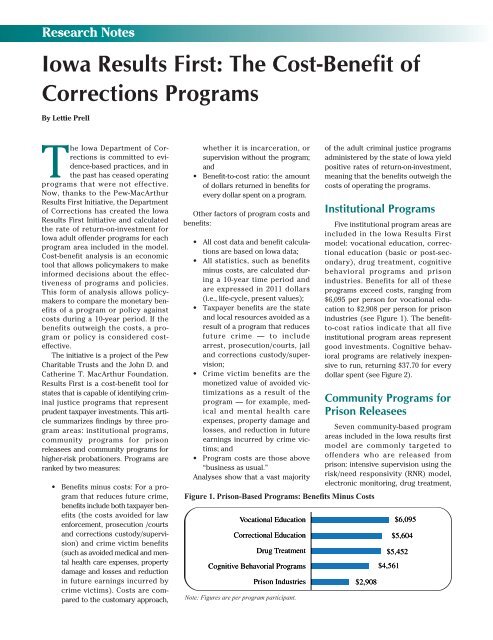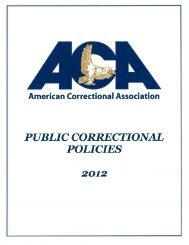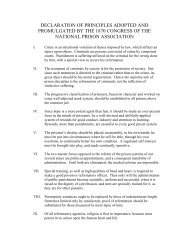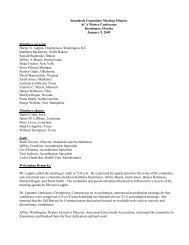Iowa Results First: The Cost-Benefit of Corrections Programs
Iowa Results First: The Cost-Benefit of Corrections Programs
Iowa Results First: The Cost-Benefit of Corrections Programs
Create successful ePaper yourself
Turn your PDF publications into a flip-book with our unique Google optimized e-Paper software.
Research Notes<br />
<strong>Iowa</strong> <strong>Results</strong> <strong>First</strong>: <strong>The</strong> <strong>Cost</strong>-<strong>Benefit</strong> <strong>of</strong><br />
<strong>Corrections</strong> <strong>Programs</strong><br />
By Lettie Prell<br />
<strong>The</strong> <strong>Iowa</strong> Department <strong>of</strong> <strong>Corrections</strong><br />
is committed to evidence-based<br />
practices, and in<br />
the past has ceased operating<br />
programs that were not effective.<br />
Now, thanks to the Pew-MacArthur<br />
<strong>Results</strong> <strong>First</strong> Initiative, the Department<br />
<strong>of</strong> <strong>Corrections</strong> has created the <strong>Iowa</strong><br />
<strong>Results</strong> <strong>First</strong> Initiative and calculated<br />
the rate <strong>of</strong> return-on-investment for<br />
<strong>Iowa</strong> adult <strong>of</strong>fender programs for each<br />
program area included in the model.<br />
<strong>Cost</strong>-benefit analysis is an economic<br />
tool that allows policymakers to make<br />
informed decisions about the effectiveness<br />
<strong>of</strong> programs and policies.<br />
This form <strong>of</strong> analysis allows policymakers<br />
to compare the monetary benefits<br />
<strong>of</strong> a program or policy against<br />
costs during a 10-year period. If the<br />
benefits outweigh the costs, a program<br />
or policy is considered costeffective.<br />
<strong>The</strong> initiative is a project <strong>of</strong> the Pew<br />
Charitable Trusts and the John D. and<br />
Catherine T. MacArthur Foundation.<br />
<strong>Results</strong> <strong>First</strong> is a cost-benefit tool for<br />
states that is capable <strong>of</strong> identifying criminal<br />
justice programs that represent<br />
prudent taxpayer investments. This article<br />
summarizes findings by three program<br />
areas: institutional programs,<br />
community programs for prison<br />
releasees and community programs for<br />
higher-risk probationers. <strong>Programs</strong> are<br />
ranked by two measures:<br />
• <strong>Benefit</strong>s minus costs: For a program<br />
that reduces future crime,<br />
benefits include both taxpayer benefits<br />
(the costs avoided for law<br />
enforcement, prosecution /courts<br />
and corrections custody/supervision)<br />
and crime victim benefits<br />
(such as avoided medical and mental<br />
health care expenses, property<br />
damage and losses and reduction<br />
in future earnings incurred by<br />
crime victims). <strong>Cost</strong>s are compared<br />
to the customary approach,<br />
whether it is incarceration, or<br />
supervision without the program;<br />
and<br />
• <strong>Benefit</strong>-to-cost ratio: the amount<br />
<strong>of</strong> dollars returned in benefits for<br />
every dollar spent on a program.<br />
Other factors <strong>of</strong> program costs and<br />
benefits:<br />
• All cost data and benefit calculations<br />
are based on <strong>Iowa</strong> data;<br />
• All statistics, such as benefits<br />
minus costs, are calculated during<br />
a 10-year time period and<br />
are expressed in 2011 dollars<br />
(i.e., life-cycle, present values);<br />
• Taxpayer benefits are the state<br />
and local resources avoided as a<br />
result <strong>of</strong> a program that reduces<br />
future crime — to include<br />
arrest, prosecution/courts, jail<br />
and corrections custody/supervision;<br />
• Crime victim benefits are the<br />
monetized value <strong>of</strong> avoided victimizations<br />
as a result <strong>of</strong> the<br />
program — for example, medical<br />
and mental health care<br />
expenses, property damage and<br />
losses, and reduction in future<br />
earnings incurred by crime victims;<br />
and<br />
• Program costs are those above<br />
“business as usual.”<br />
Analyses show that a vast majority<br />
Figure 1. Prison-Based <strong>Programs</strong>: <strong>Benefit</strong>s Minus <strong>Cost</strong>s<br />
Vocational Education<br />
Correctional Education<br />
Drug Treatment<br />
Cognitive Behavorial <strong>Programs</strong><br />
Note: Figures are per program participant.<br />
<strong>of</strong> the adult criminal justice programs<br />
administered by the state <strong>of</strong> <strong>Iowa</strong> yield<br />
positive rates <strong>of</strong> return-on-investment,<br />
meaning that the benefits outweigh the<br />
costs <strong>of</strong> operating the programs.<br />
Institutional <strong>Programs</strong><br />
Prison Industries $2,908<br />
Five institutional program areas are<br />
included in the <strong>Iowa</strong> <strong>Results</strong> <strong>First</strong><br />
model: vocational education, correctional<br />
education (basic or post-secondary),<br />
drug treatment, cognitive<br />
behavioral programs and prison<br />
industries. <strong>Benefit</strong>s for all <strong>of</strong> these<br />
programs exceed costs, ranging from<br />
$6,095 per person for vocational education<br />
to $2,908 per person for prison<br />
industries (see Figure 1). <strong>The</strong> benefitto-cost<br />
ratios indicate that all five<br />
institutional program areas represent<br />
good investments. Cognitive behavioral<br />
programs are relatively inexpensive<br />
to run, returning $37.70 for every<br />
dollar spent (see Figure 2).<br />
Community <strong>Programs</strong> for<br />
Prison Releasees<br />
Seven community-based program<br />
areas included in the <strong>Iowa</strong> results first<br />
model are commonly targeted to<br />
<strong>of</strong>fenders who are released from<br />
prison: intensive supervision using the<br />
risk/need responsivity (RNR) model,<br />
electronic monitoring, drug treatment,<br />
$6,095<br />
$5,604<br />
$5,452<br />
$4,561
Figure 2. Prison-Based <strong>Programs</strong>: <strong>Benefit</strong> Return<br />
For every dollar spent on these programs, the amount <strong>of</strong> benefit returned is:<br />
Cognitive Behavioral <strong>Programs</strong><br />
$37.70<br />
Drug Treatment $8.25<br />
with a caseload <strong>of</strong> 50 <strong>of</strong>fenders)<br />
reduces overall recidivism by 25.5 percent<br />
for a new crime, and reduces the<br />
rate <strong>of</strong> recidivism for new property<br />
and violent crimes by 45 percent. 3<br />
<strong>Iowa</strong>’s intensive supervision programs<br />
all incorporate treatment. However,<br />
not all programs adhere to the RNR<br />
model or maintain the optimal caseload<br />
size.<br />
Vocational Education<br />
Correctional Education<br />
N<br />
Note: Prison industries is excluded from this figure because no taxpayer dollars are spent on this<br />
category.<br />
intensive supervision with treatment,<br />
work release, cognitive behavioral programs<br />
and employment training/job<br />
assistance. <strong>Benefit</strong>s for all <strong>of</strong> these programs<br />
exceed costs, ranging from $9,097<br />
for intensive supervision using the RNR<br />
model, to $2,168 for employment training/job<br />
assistance (see Figure 3). <strong>The</strong><br />
benefit-to-cost ratios indicate that all <strong>of</strong><br />
these community-based program areas<br />
represent solid investments. Cognitive<br />
behavioral programs are also very<br />
inexpensive to run, returning $34.30 for<br />
every dollar spent (see Figure 4). <strong>The</strong><br />
RNR model developed by Andrews,<br />
Bonta and Hoge 1 is based on three<br />
principles:<br />
$4.52<br />
$2.91<br />
also included findings <strong>of</strong> an optimal<br />
caseload size in order to effectively<br />
deliver RNR. <strong>The</strong> research found that<br />
an intensive supervision caseload size<br />
<strong>of</strong> 30 <strong>of</strong>fenders per <strong>of</strong>ficer (compared<br />
Community <strong>Programs</strong> for<br />
Higher-Risk Probationers<br />
In <strong>Iowa</strong>, <strong>of</strong>fenders not sentenced to<br />
prison normally receive communitybased<br />
supervision. Eight communitybased<br />
program areas included in the<br />
<strong>Iowa</strong> results first model are commonly<br />
targeted to higher-risk probationers:<br />
intensive supervision using the RNR<br />
model, drug courts, mental health<br />
courts, electronic monitoring, drug<br />
treatment, intensive supervision with<br />
treatment, cognitive behavioral programs<br />
and employment training/<br />
job assistance. <strong>Benefit</strong>s for all <strong>of</strong> these<br />
programs exceed costs, ranging from<br />
Figure 3. Community <strong>Programs</strong> for Prison Releasees: <strong>Benefit</strong>s Minus <strong>Cost</strong>s<br />
Intensive Supervision RNR Model<br />
Electronic Monitoring<br />
Drug Treatment<br />
Intensive Supervision w/Treatment<br />
Work Release<br />
Cognitive Behavioral <strong>Programs</strong><br />
Employment Training/Job Assistance<br />
$2,168<br />
$7,706<br />
$7, 367<br />
$5,876<br />
$4,751<br />
$4,474<br />
$9.097<br />
• Risk principle: An <strong>of</strong>fender’s<br />
level <strong>of</strong> service should reflect<br />
his or her risk <strong>of</strong> recidivism;<br />
• Need principle: An <strong>of</strong>fender’s<br />
criminogenic needs should be<br />
assessed and targeted for treatment,<br />
with higher-risk <strong>of</strong>fenders<br />
receiving the most intensive<br />
treatment; and<br />
• Responsivity principle: <strong>The</strong> type<br />
<strong>of</strong> intervention should correspond<br />
with the <strong>of</strong>fender’s<br />
strengths and motivations.<br />
<strong>The</strong> RNR model typically supports<br />
cognitive-behavioral or social-learning<br />
treatments. 2 <strong>The</strong> effectiveness <strong>of</strong> the<br />
RNR model shown in this article is<br />
based, in part, on research <strong>of</strong> <strong>of</strong>fenders<br />
supervised in Polk County, <strong>Iowa</strong>, that<br />
Note: Figures are per program participant.<br />
Figure 4. Community <strong>Programs</strong> for Prison Releasees: <strong>Benefit</strong> Return<br />
For every dollar spent on these programs, the amount <strong>of</strong> benefit returned is:<br />
Cognitive Behavioral <strong>Programs</strong><br />
Drug Treatment<br />
$8.98<br />
Intensive Supervision: RNR Treatment<br />
$7.18<br />
Electronic Monitoring $6.43<br />
Employment Training/Job Assistance $5.02<br />
Intensive Supervision w/Treatment $5.01<br />
Note: N Work release is excluded because benefit-to-cost ratio could not be computed.<br />
$34.30
Figure 5. Community <strong>Programs</strong> for Higher-Risk Probationers: <strong>Benefit</strong>s<br />
Minus <strong>Cost</strong>s<br />
Mental Health Courts<br />
Intensive Supervision: RNR Model<br />
Drug Courts<br />
Electronic Monitoring<br />
Drug Treatment<br />
Intensive Supervision w/Treatment<br />
Cognitive Behavioral <strong>Programs</strong><br />
Employment Training/Job Assistance<br />
Note: Figures N are per program participant.<br />
Figure 6. Community <strong>Programs</strong> for Higher-Risk Probationers: <strong>Benefit</strong> Return<br />
$4,961 for mental health courts, to<br />
$1,010 for employment training/job<br />
assistance (see Figure 5). <strong>The</strong> benefitto-cost<br />
ratios indicate that all eight <strong>of</strong><br />
the community-based programs represent<br />
good investments. Cognitive<br />
behavioral programs are also very<br />
inexpensive to run, returning $19.46<br />
for every dollar spent (see Figure 6).<br />
Lower benefit-to-cost ratios for<br />
many program areas here for probationers<br />
compared to those for<br />
released <strong>of</strong>fenders does not mean<br />
these programs are less effective in<br />
treating probationers compared with<br />
the latter. Rather, prison releasees<br />
tend to have higher rates <strong>of</strong> reconviction<br />
compared to probationers, so<br />
community corrections programs for<br />
prison releasees produces more benefits<br />
in terms <strong>of</strong> reduced crime. If<br />
$1,010<br />
$2,620<br />
$2,475<br />
these programs are delivered to probationers<br />
who are assessed as lowerrisk,<br />
fewer benefits to taxpayers — or<br />
no benefits at all — will result. For<br />
the <strong>Iowa</strong> results first model, higherrisk<br />
probationers were defined as<br />
those <strong>of</strong>fenders who were supervised<br />
at the high-normal level <strong>of</strong> supervision<br />
or intensive supervision during<br />
at least a portion <strong>of</strong> their supervision<br />
period. <strong>The</strong>se probationers are also<br />
the usual core target group to receive<br />
the treatment programs shown.<br />
Program Fidelity<br />
$4,961<br />
$4,508<br />
$4,450<br />
$3,827<br />
$3,794<br />
For every dollar spent on these programs, the amount <strong>of</strong> benefit returned is:<br />
Cognitive Behavior <strong>Programs</strong><br />
Drug Courts<br />
Drug Treatment<br />
Intensive Supervision: RNR Model<br />
Electronic Monitoring<br />
Employment Training/Job Assistance<br />
Intensive Treatment w/Supervision<br />
$5.11<br />
$4.06<br />
$3.70<br />
$2.88<br />
$2.78<br />
$9.61<br />
$19.46<br />
Note: NMental health courts are excluded because benefit-to-cost ratio could not be computed.<br />
<strong>The</strong>se results are based on a summary<br />
<strong>of</strong> good, sound research evaluations,<br />
including those conducted on<br />
<strong>Iowa</strong> <strong>of</strong>fender populations. Simply<br />
put, well-run programs — for example,<br />
those that focus on specific factors<br />
that lead to continued criminal<br />
behavior, provide a dosage/duration<br />
<strong>of</strong> treatment based on risk and match<br />
treatment with <strong>of</strong>fender characteristics<br />
— will achieve these results or<br />
better. Poorly run programs will not.<br />
<strong>The</strong> <strong>Iowa</strong> Department <strong>of</strong> <strong>Corrections</strong><br />
has evaluated the degree to which<br />
institutional and community-based<br />
corrections programs adhere to evidence-based<br />
principles. Improvement<br />
plans are in place for a number<br />
<strong>of</strong> programs.<br />
Conclusion<br />
Using the <strong>Iowa</strong> results first model,<br />
the <strong>Iowa</strong> Department <strong>of</strong> <strong>Corrections</strong><br />
assessed the rate <strong>of</strong> return <strong>Iowa</strong> taxpayers<br />
receive from investment in the<br />
state’s adult corrections programs.<br />
Findings indicate these programs<br />
yield positive returns-on-investment.<br />
<strong>Cost</strong>-benefit analysis is a powerful<br />
tool during these challenging budgetary<br />
times for states. Internally, it<br />
focuses the <strong>Iowa</strong> Department <strong>of</strong> <strong>Corrections</strong><br />
on program fidelity and<br />
shifting resources toward expanding<br />
programs that both work and are<br />
economical, such as cognitive-behavioral<br />
treatment. <strong>The</strong> <strong>Iowa</strong> results first<br />
model also assists in providing budget<br />
decision-makers with sound information<br />
on the role corrections may<br />
play in further reducing admissions<br />
to jails and prisons, as well as keeping<br />
citizens safer.<br />
ENDNOTES<br />
1 Andrews, D.A., J. Bonta and R.D. Hoge.<br />
1990. Classification for effective rehabilitation:<br />
Rediscovering psychology. Criminal<br />
Justice and Behavior, 17(1):19-52.<br />
2 Ibid.<br />
3 Jalbert, S.K., W. Rhodes, C. Flygare and<br />
M. Kane. 2010. Testing probation outcomes<br />
in an evidence-based practice setting:<br />
Reduced caseload size and intensive<br />
supervision effectiveness. Journal <strong>of</strong><br />
Offender Rehabilitation, 49(4):233-253.<br />
Lettie Prell is director <strong>of</strong> research at the<br />
<strong>Iowa</strong> Department <strong>of</strong> <strong>Corrections</strong>.





